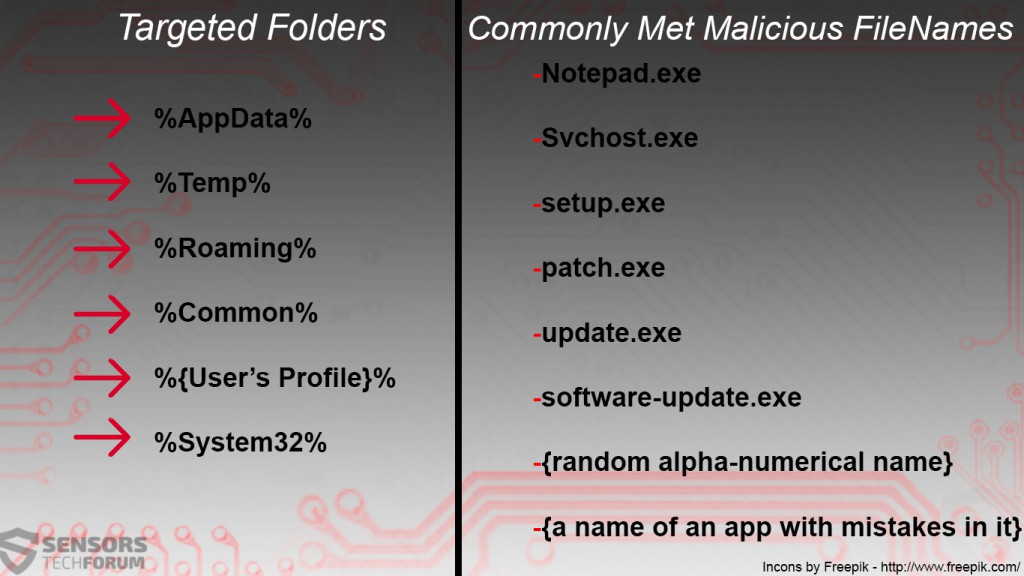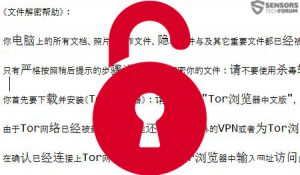 Shujin ransomware, written entirely in Chinese has been reported on security forum to infect unsuspecting users. The ransom note is written entirely in Chinese, and the encoded files are in the .txt file extension. This particular ransomware, like many others, uses a strong encryption to encode the users’ data and extorts the users for the return of their files. Users who have been affected by this cyber threat should be aware that at this point there is no relevant decryption possibility. However, they can remove the threat and may restore their data using alternative methods such as the ones after this article.
Shujin ransomware, written entirely in Chinese has been reported on security forum to infect unsuspecting users. The ransom note is written entirely in Chinese, and the encoded files are in the .txt file extension. This particular ransomware, like many others, uses a strong encryption to encode the users’ data and extorts the users for the return of their files. Users who have been affected by this cyber threat should be aware that at this point there is no relevant decryption possibility. However, they can remove the threat and may restore their data using alternative methods such as the ones after this article.

Threat Summary
| Name | Shujin Ransomware |
| Type | Ransomware |
| Short Description | The ransomware encrypts files with a strong cypher and asks a ransom for decryption. |
| Symptoms | Files are encrypted in the “.txt file extension” and become inaccessible. A ransom note with instructions for paying the ransom is written in Chinese. |
| Distribution Method | Spam Emails, Email Attachments, File Sharing Networks. |
| Detection Tool |
See If Your System Has Been Affected by malware
Download
Malware Removal Tool
|
| User Experience | Join our forum to Discuss Shujin Ransomware. |
| Data Recovery Tool | Windows Data Recovery by Stellar Phoenix Notice! This product scans your drive sectors to recover lost files and it may not recover 100% of the encrypted files, but only few of them, depending on the situation and whether or not you have reformatted your drive. |

Shujin Ransomware – Spread
To be widely redistributed over the web, this particular crypto-malware may use a variety of methods. The most frequently met distribution tactics used by ransomware are the following:
- Infection via malicious URLs posted on spam e-mail messages, social media messages and commends and chat messages.
- Infections via redirects to malicious drive-by URLs caused by PUPs, for example, DNS Unlocker.
- Distribution of the malicious files via obfuscated processes, pretending to be setups of programs or torrent files that users search for online for free download.
Whatever the method may be, once this ransomware is on your computer, it may execute scripts that enable it to slip onto the PC undetected by security software.

Shujin Ransomware In Detail
Once executed, the ransomware may deploy its malicious files in key windows folders. The folders vary, since the file formats may also vary. For example, if the modules for encryption it uses are .tmp files, they are usually dropped In the %Temp% folder. The names of the malicious files may also vary. Here are the common paths and filenames that Chinese Ransomware may utilize to infect your device:
After dropping its files, the ransomware may tamper with several key registry entries in the Windows Registry Editor. Users who have been infected by Chinese Ransomware should check the following registry entries:
→ HKEY_CURRENT_USER\Software\Microsoft\Windows\CurrentVersion\Explorer\Shell Folders
HKEY_CURRENT_USER\Software\Microsoft\Windows\CurrentVersion\Explorer\User Shell Folders
HKEY_LOCAL_MACHINE\Software\Microsoft\Windows\CurrentVersion\explorer\User Shell Folders
HKEY_LOCAL_MACHINE\Software\Microsoft\Windows\CurrentVersion\explorer\Shell Folders]
HKEY_LOCAL_MACHINE\Software\Microsoft\Windows\CurrentVersion\RunServices
HKEY_LOCAL_MACHINE\Software\Microsoft\Windows\CurrentVersion\RunServicesOnce
HKEY_LOCAL_MACHINE\Software\Microsoft\Windows\CurrentVersion\Run
HKEY_LOCAL_MACHINE\Software\Microsoft\Windows\CurrentVersion\RunOnce
HKEY_CURRENT_USER\Software\Microsoft\Windows\CurrentVersion\Run
HKEY_CURRENT_USER\Software\Microsoft\Windows\CurrentVersion\RunOnce
HKEY_CURRENT_USER\Software\Microsoft\Windows\CurrentVersion\RunServices
HKEY_LOCAL_MACHINE\Software\CLASSES
After this is done, Chinese ransomware may execute a “call” script to launch the encryption process. It may scan through the infected to a computer for some of the most commonly used file types. After scanning the files are encrypted with the “.txt” file extension, for example:
→ Photo.jpg.txt
After the files are encoded they are unable to be opened and instead, users come to see a text file. Renaming the extension back to normal is reported not to help, pointing out to all of the files being rendered unusable.
Unlike other ransomware, this ransomware displays its message completely in Chinese. Here is how the message appears and to what it translates:
→ In English:“File decryption Help”:
All your documents on your computer, photos, work files, private files and other important files have been encrypted. To decrypt these files, run the
Only by strictly follow the steps later time, to decrypt your files; do not use antivirus software or other tools to try to recover any files because this will destroy or delete the encrypted file, causing the file never recover!
You must first download and install the “Tor Browser”; please Baidu search “Tor Browser Chinese version of” find the download address, download, and install; installation or download directly from the official website https://torproject.org; if you are the first 1 using this browser, you may also need to Baidu search for “Tor browser using the” Get related tutorial;
Since the Tor network has been blocked, you may also need to use an overseas VPN or configure a proxy server for foreign Tor browser; if you do not know how to do this, search for relevant information or seek professional help on the Internet;
At the confirmation has been connected to the Tor network premise Tor enter the URL in your browser to access this site: HTTP: //eqlc75eumpb77ced.onion/, if the site is temporarily unable to open, please try again later to continue;
If the decryption tool has been lost, you can re-download from a website; run decryption tool, make sure that the antivirus software is turned off;
Open the Web site, copy the following machine code to enter and submit, then follow the prompts websites; If successful, you will receive a unique key, which will be able to decrypt all your files;
The following is your machine code
In Chinese:
《文件解密帮助》:
你电脑上的所有文档、照片、工作文件、隐私文件与及其它重要文件都已经被加密。要解密这些文件,请运行桌面上的<文件解密>工具;如果桌面上没有这个工具,请前往每一个分区的根目录下查找;如果仍然无法找到该工具,请继续阅读此帮助内容;
只有严格按照稍后提示的步骤进行,才能解密你的文件;请不要使用杀毒软件或者其它任何工具尝试恢复文件,因为这将会破坏或删除被加密的文件,导致文件永远无法恢复!
你首先要下载并安装《Tor浏览器》;请百度搜索”Tor浏览器中文版”,找到下载地址,下载并安装;或者直接从官网 https://torproject.org 上下载安装; 如果你是第1次使用此浏览器,你可能还需要百度搜索”Tor浏览器使用”获取相关的使用教程;
由于Tor网络已经被封锁,你可能还需要使用国外的VPN或者为Tor浏览器配置国外代理服务器;如果你并不懂得如何操作,请在网上搜索相关的资料或者寻求专业人员的帮助;
在确认已经连接上Tor网络的前提下,在Tor浏览器中输入网址访问此网站:https://87g98n0m87ug.onion/ ,如果网站暂时无法打开,请稍后继续重试;
如果解密工具已丢失,你可以从此网站上重新下载一个;运行解密工具的时候,请确保杀毒软件处于关闭状态;
打开网站后,复制以下机器码输入并提交,然后根据网站的提示进行操作;如果成功,你将获得一个唯一的密钥,这个密钥将可以解密你所有的文件;
以下是你的机器码:(请确保复制完整)
Users are strongly advised not to pay the ransom money by this Chinese Ransomware because the cyber-criminals have restored only a percentage of the files. Another reason not to pay is that you may fund the cybercriminal organization to further develop the ransomware and infect even more computers. Instead, we advise you to wipe this crypto-malware and use alternative tactics to get your files back.

Removing Shujin Ransomware and Restoring the Data May Be Tricky
If you want to remove the ransomware, you may run into some difficulties if you do it manually. This is because this virus may use different files and drop them in different locations every time. Not only this but Chinese ransomware, may prevent you from deleting the files by using escalated privileges. This is why we advise you to isolate and remove it by using the instructions below.
In case you are looking forward to restoring your data, make sure to follow our forum or this blog page for any updates. We will post one as soon as it is available. In the meantime, we suggest you try and see if you can restore your files via the methods which are illustrated in the step “Restore files encrypted by Chinese Ransomware”.
- Step 1
- Step 2
- Step 3
- Step 4
- Step 5
Step 1: Scan for Shujin Ransomware with SpyHunter Anti-Malware Tool



Ransomware Automatic Removal - Video Guide
Step 2: Uninstall Shujin Ransomware and related malware from Windows
Here is a method in few easy steps that should be able to uninstall most programs. No matter if you are using Windows 10, 8, 7, Vista or XP, those steps will get the job done. Dragging the program or its folder to the recycle bin can be a very bad decision. If you do that, bits and pieces of the program are left behind, and that can lead to unstable work of your PC, errors with the file type associations and other unpleasant activities. The proper way to get a program off your computer is to Uninstall it. To do that:


 Follow the instructions above and you will successfully delete most unwanted and malicious programs.
Follow the instructions above and you will successfully delete most unwanted and malicious programs.
Step 3: Clean any registries, created by Shujin Ransomware on your computer.
The usually targeted registries of Windows machines are the following:
- HKEY_LOCAL_MACHINE\Software\Microsoft\Windows\CurrentVersion\Run
- HKEY_CURRENT_USER\Software\Microsoft\Windows\CurrentVersion\Run
- HKEY_LOCAL_MACHINE\Software\Microsoft\Windows\CurrentVersion\RunOnce
- HKEY_CURRENT_USER\Software\Microsoft\Windows\CurrentVersion\RunOnce
You can access them by opening the Windows registry editor and deleting any values, created by Shujin Ransomware there. This can happen by following the steps underneath:


 Tip: To find a virus-created value, you can right-click on it and click "Modify" to see which file it is set to run. If this is the virus file location, remove the value.
Tip: To find a virus-created value, you can right-click on it and click "Modify" to see which file it is set to run. If this is the virus file location, remove the value.
Before starting "Step 4", please boot back into Normal mode, in case you are currently in Safe Mode.
This will enable you to install and use SpyHunter 5 successfully.
Step 4: Boot Your PC In Safe Mode to isolate and remove Shujin Ransomware





Step 5: Try to Restore Files Encrypted by Shujin Ransomware.
Method 1: Use STOP Decrypter by Emsisoft.
Not all variants of this ransomware can be decrypted for free, but we have added the decryptor used by researchers that is often updated with the variants which become eventually decrypted. You can try and decrypt your files using the instructions below, but if they do not work, then unfortunately your variant of the ransomware virus is not decryptable.
Follow the instructions below to use the Emsisoft decrypter and decrypt your files for free. You can download the Emsisoft decryption tool linked here and then follow the steps provided below:
1 Right-click on the decrypter and click on Run as Administrator as shown below:

2. Agree with the license terms:
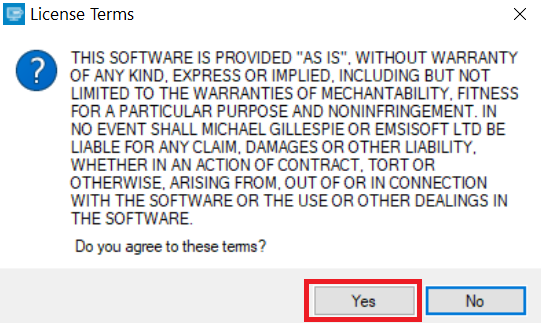
3. Click on "Add Folder" and then add the folders where you want files decrypted as shown underneath:
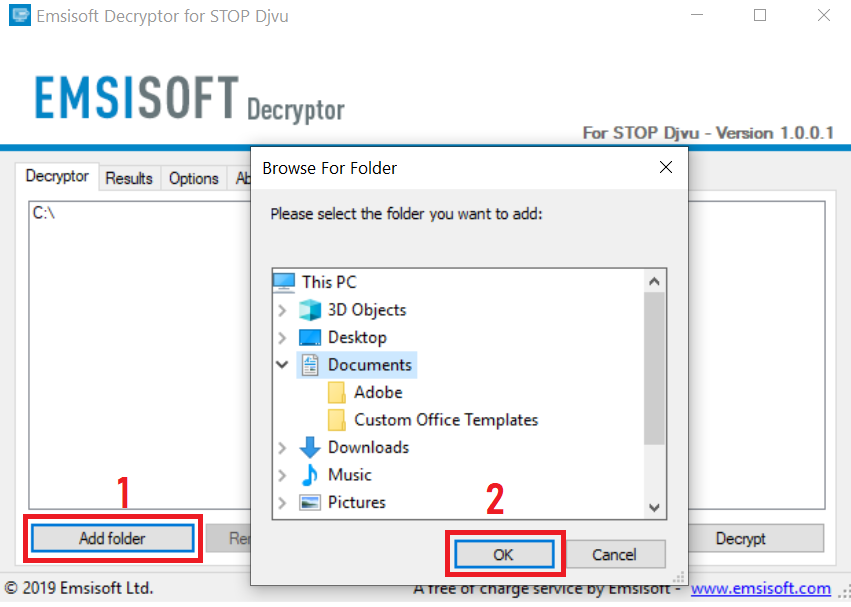
4. Click on "Decrypt" and wait for your files to be decoded.
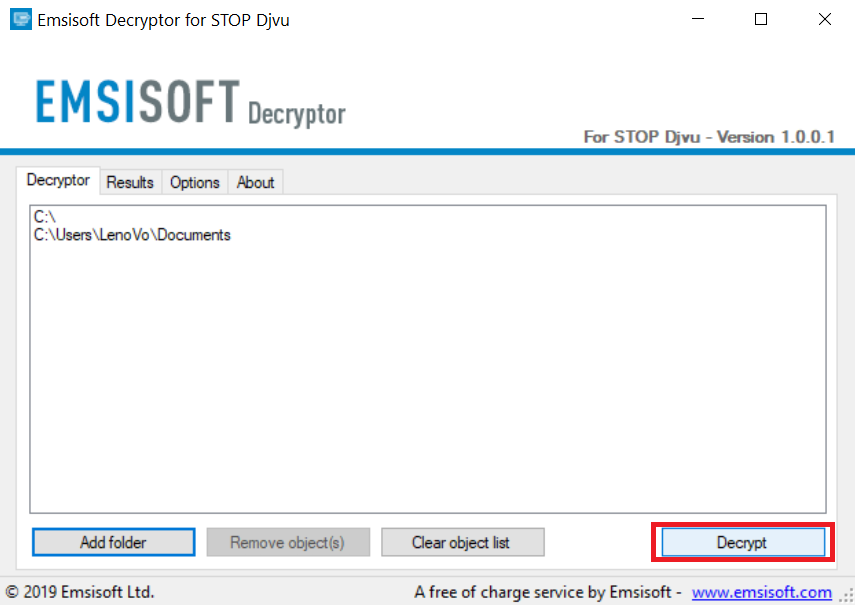
Note: Credit for the decryptor goes to Emsisoft researchers who have made the breakthrough with this virus.
Method 2: Use data recovery software
Ransomware infections and Shujin Ransomware aim to encrypt your files using an encryption algorithm which may be very difficult to decrypt. This is why we have suggested a data recovery method that may help you go around direct decryption and try to restore your files. Bear in mind that this method may not be 100% effective but may also help you a little or a lot in different situations.
Simply click on the link and on the website menus on the top, choose Data Recovery - Data Recovery Wizard for Windows or Mac (depending on your OS), and then download and run the tool.
Shujin Ransomware-FAQ
What is Shujin Ransomware Ransomware?
Shujin Ransomware is a ransomware infection - the malicious software that enters your computer silently and blocks either access to the computer itself or encrypt your files.
Many ransomware viruses use sophisticated encryption algorithms to make your files inaccessible. The goal of ransomware infections is to demand that you pay a ransom payment to get access to your files back.
What Does Shujin Ransomware Ransomware Do?
Ransomware in general is a malicious software that is designed to block access to your computer or files until a ransom is paid.
Ransomware viruses can also damage your system, corrupt data and delete files, resulting in the permanent loss of important files.
How Does Shujin Ransomware Infect?
Via several ways.Shujin Ransomware Ransomware infects computers by being sent via phishing emails, containing virus attachment. This attachment is usually masked as an important document, like an invoice, bank document or even a plane ticket and it looks very convincing to users.
Another way you may become a victim of Shujin Ransomware is if you download a fake installer, crack or patch from a low reputation website or if you click on a virus link. Many users report getting a ransomware infection by downloading torrents.
How to Open .Shujin Ransomware files?
You can't without a decryptor. At this point, the .Shujin Ransomware files are encrypted. You can only open them once they are decrypted using a specific decryption key for the particular algorithm.
What to Do If a Decryptor Does Not Work?
Do not panic, and backup the files. If a decryptor did not decrypt your .Shujin Ransomware files successfully, then do not despair, because this virus is still new.
Can I Restore ".Shujin Ransomware" Files?
Yes, sometimes files can be restored. We have suggested several file recovery methods that could work if you want to restore .Shujin Ransomware files.
These methods are in no way 100% guaranteed that you will be able to get your files back. But if you have a backup, your chances of success are much greater.
How To Get Rid of Shujin Ransomware Virus?
The safest way and the most efficient one for the removal of this ransomware infection is the use a professional anti-malware program.
It will scan for and locate Shujin Ransomware ransomware and then remove it without causing any additional harm to your important .Shujin Ransomware files.
Can I Report Ransomware to Authorities?
In case your computer got infected with a ransomware infection, you can report it to the local Police departments. It can help authorities worldwide track and determine the perpetrators behind the virus that has infected your computer.
Below, we have prepared a list with government websites, where you can file a report in case you are a victim of a cybercrime:
Cyber-security authorities, responsible for handling ransomware attack reports in different regions all over the world:
Germany - Offizielles Portal der deutschen Polizei
United States - IC3 Internet Crime Complaint Centre
United Kingdom - Action Fraud Police
France - Ministère de l'Intérieur
Italy - Polizia Di Stato
Spain - Policía Nacional
Netherlands - Politie
Poland - Policja
Portugal - Polícia Judiciária
Greece - Cyber Crime Unit (Hellenic Police)
India - Mumbai Police - CyberCrime Investigation Cell
Australia - Australian High Tech Crime Center
Reports may be responded to in different timeframes, depending on your local authorities.
Can You Stop Ransomware from Encrypting Your Files?
Yes, you can prevent ransomware. The best way to do this is to ensure your computer system is updated with the latest security patches, use a reputable anti-malware program and firewall, backup your important files frequently, and avoid clicking on malicious links or downloading unknown files.
Can Shujin Ransomware Ransomware Steal Your Data?
Yes, in most cases ransomware will steal your information. It is a form of malware that steals data from a user's computer, encrypts it, and then demands a ransom in order to decrypt it.
In many cases, the malware authors or attackers will threaten to delete the data or publish it online unless the ransom is paid.
Can Ransomware Infect WiFi?
Yes, ransomware can infect WiFi networks, as malicious actors can use it to gain control of the network, steal confidential data, and lock out users. If a ransomware attack is successful, it could lead to a loss of service and/or data, and in some cases, financial losses.
Should I Pay Ransomware?
No, you should not pay ransomware extortionists. Paying them only encourages criminals and does not guarantee that the files or data will be restored. The better approach is to have a secure backup of important data and be vigilant about security in the first place.
What Happens If I Don't Pay Ransom?
If you don't pay the ransom, the hackers may still have access to your computer, data, or files and may continue to threaten to expose or delete them, or even use them to commit cybercrimes. In some cases, they may even continue to demand additional ransom payments.
Can a Ransomware Attack Be Detected?
Yes, ransomware can be detected. Anti-malware software and other advanced security tools can detect ransomware and alert the user when it is present on a machine.
It is important to stay up-to-date on the latest security measures and to keep security software updated to ensure ransomware can be detected and prevented.
Do Ransomware Criminals Get Caught?
Yes, ransomware criminals do get caught. Law enforcement agencies, such as the FBI, Interpol and others have been successful in tracking down and prosecuting ransomware criminals in the US and other countries. As ransomware threats continue to increase, so does the enforcement activity.
About the Shujin Ransomware Research
The content we publish on SensorsTechForum.com, this Shujin Ransomware how-to removal guide included, is the outcome of extensive research, hard work and our team’s devotion to help you remove the specific malware and restore your encrypted files.
How did we conduct the research on this ransomware?
Our research is based on an independent investigation. We are in contact with independent security researchers, and as such, we receive daily updates on the latest malware and ransomware definitions.
Furthermore, the research behind the Shujin Ransomware ransomware threat is backed with VirusTotal and the NoMoreRansom project.
To better understand the ransomware threat, please refer to the following articles which provide knowledgeable details.
As a site that has been dedicated to providing free removal instructions for ransomware and malware since 2014, SensorsTechForum’s recommendation is to only pay attention to trustworthy sources.
How to recognize trustworthy sources:
- Always check "About Us" web page.
- Profile of the content creator.
- Make sure that real people are behind the site and not fake names and profiles.
- Verify Facebook, LinkedIn and Twitter personal profiles.













